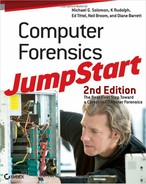Introduction
Want to know what computer forensic examiners really do? This book covers the essentials of computer forensics, and it’s especially designed for those new to the field or who simply wish to learn more about undertaking this type of work. Many news stories and television shows highlight the role of forensic investigators in solving cases. It all seems so exciting, doesn’t it? Computer forensics is really not that different from what you see on TV. Although it’s quite a bit less glamorous, you’ll find similarities in the real world.
After a crime or incident that involves a computer occurs, a specialist trained in computer forensics examines the computer to find clues about what happened. That is the role of the computer forensic examiner. This specialist may work with law enforcement or with a corporate incident response team. Although the rules governing each activity can be dramatically different depending on who your client is, the approach to the investigation remains roughly the same.
This book covers the basic elements, concepts, tools, and common activities to equip you with a solid understanding of the field of computer forensics. Although this book is not a definitive training guide for specific forensic tools, you will learn about the most common tasks that you’ll encounter during any investigation. After reading this book, you will be able to participate in investigations and understand the process of finding, collecting, and analyzing the evidence gathered.
A heightened awareness of security in the wake of the attacks on September 11, 2001, has also provided many nontechnical people with an awareness of security issues previously known only in security specialist circles. Computers play a central role in all activities, both legal and illegal. The material in this book can be applied to both criminal investigations and corporate incident response. You don’t have to be a member of law enforcement to benefit from the material presented here. Nontechnical people can also benefit from this book because it covers the basic approach computer examiners take in an investigation.
If you like the introduction to computer forensics we present in this book, you can pursue the topic further in several ways. Most major forensic tools vendors offer training on their own products and teach how to use them in investigations. See Chapter 8, “Common Forensic Tools,” and Appendix D, “Forensic Tools,” for more information. Appendix B, “Forensic Resources,” contains many references to resources where you can obtain more information. If you decide to pursue computer forensic certification, Appendix C, “Forensic Certifications and More,” provides a list of common certifications and contact information for each. If your job involves computer investigations, this book can help you expand your knowledge and abilities. Keep it handy as a resource as you acquire more experience and knowledge. And good luck with your pursuit!
